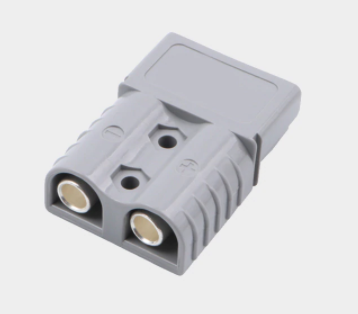Anderson plugs are increasingly used by camper-trailer and caravan owners to recharge auxiliary batteries while they are driving and power electrical accessories while they are camping.
In this guide, you will learn:
- What an Anderson Plug is
- If you need an Anderson plug
- The benefits of an Anderson plug
- Different colours and sizes, what they mean
- Costs of installing an Anderson plug
What is an Anderson plug?
An Anderson plug is a specialised electrical component used in 12-volt, high current, dual battery systems.
What Does It Do?
Anderson plugs play several roles. They allow a vehicle battery or alternator to be connected to an auxiliary battery in a trailer or caravan so that the auxiliary can be charged while the vehicle is driven to a destination.
They allow a vehicle battery to power the electronic stability control system in a trailer or caravan in tow and can be used as an alternative to the cigarette lighter socket as a source of 12-volt power. At a campsite, the plug allows solar panels to be connected to and recharge batteries.



Vehicle-to-trailer connections (charging circuits)
The Anderson plug is ideal to use in charging circuits. The most common use is for charging the auxiliary battery in a trailer or caravan when driving.
This avoids the unnecessary noise and costs of having to run the vehicle engine to charge the auxiliary when stationary at a campsite.
Powering an electronic stability control system
Many modern camping trailers and caravans are fitted with an electronic stability control system.
This system can be powered through a 12-pin plug when driving, but an Anderson plug provides a better connection. Its secure locking design virtually eliminates all risk of connecting cables coming loose.
12-volt accessory power alternative
Anderson plugs make a great alternative for powering high-draw 12-volt accessories such as fridges and air compressors that usually connect to the standard cigarette lighter socket.
Standard devices that connect to a cigarette lighter can ‘pop-out’ over bumpy, off-road tracks.
Connection to solar panels
More and more campers are using solar panels as a power source. Anderson plugs can be used to connect batteries, via a regulator, to solar panels to top up the batteries.
An auxiliary battery powers a camping fridge and a couple of small accessories for about two days. Recharging an auxiliary can require running the vehicle engine a full day.
The annoying noise and petrol cost of this process is a major reason why solar panels have become so popular for recharging auxiliary batteries.
Looking for a new caravan? Get your next caravan sooner, with low rate finance from Credit One.
Do I Need An Anderson Plug?
Yes. If you own a modern trailer or caravan you probably have an Anderson plug installed to the unit by the manufacturer. All you then need is one installed to your vehicle. The plug is increasingly used by 4WD owners and campers.
Benefits Of An Anderson Plug
When used for vehicle-to-trailer connections, an Anderson plug is a safer, more convenient alternative to a 12-pin plug. It is safer because it is specifically designed to handle a continuous charging load.
It is more convenient because it provides a more secure connection between a vehicle and a trailer in tow.
A continuous, high charging load through a 12-pin plug can melt the pins since they are not designed to handle high loads from modern alternators. Moreover, Anderson plugs stay locked in place and better maintain their connection, even when driving off-road over the roughest terrains.
Colours & Sizes
Anderson connectors and plugs come in a limited range of colours and a variety of sizes. Grey, red, and blue are the most common colours. Colour is important because a grey plug can only be used with another grey plug, a red plug with another red plug, and the same for blue plugs.



There are a few reasons to install different coloured plugs. The main one is so that a user can better remember to connect the correct application or accessory to the correct circuit. For example, some users install a red plug to power an electronic stability control system and a grey plug to power other accessories.
The most common units are 50-amp grey or red plugs and connectors. The bigger the current in the circuit, the bigger the required size. Plugs up to 350-amp are available.
How much does it cost to fit an Anderson plug?
An Anderson plug is easy to install with a few simple tools such as a crimper, screwdriver, and power drill.
The wiring work is best done by a registered auto-electrician. The plug itself costs less than A$20. The wiring and installation work can cost up to $200 depending on the vehicle.
The plug is affixed to the rear of the vehicle and then wired to either the vehicle alternator or battery. The cost of installing a plug on a trailer or caravan is usually less than a vehicle installation.
Many trailer and caravan manufacturers install an Anderson plug to their units. This growing trend speaks to their safety and convenience.
The plugs are distributed through a range of auto-electrical outlets across the country. They are also available online through eBay. The plugs are weatherproof, but specially designed covers can be purchased to provide additional protection against weather and dust.
Conclusion
Anderson plugs are a dedicated electrical part used by campers on their vehicles, trailers, and caravans as part of a 12-volt, high current, dual battery system.
Their main benefit is that they allow auxiliary batteries to be charged while driving. This is achieved through a connection that is safer and more secure than what’s possible with a 12-pin plug.
They can also be used to recharge auxiliary batteries, power camping equipment, and connect batteries to solar panels.
If you’re looking to upgrade your caravan, camper, boat or 4WD, get a 30 second quick quote on finance with CreditOne – Australia’s best rated finance broker.




Comments